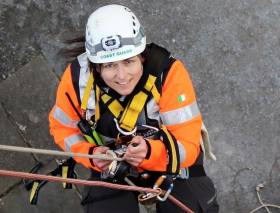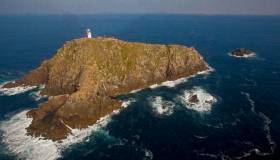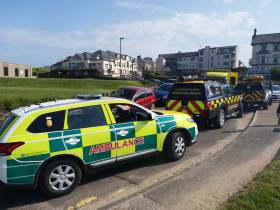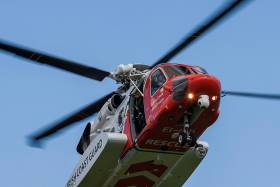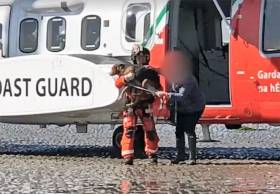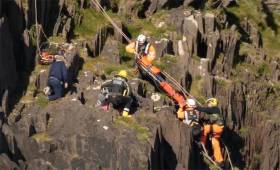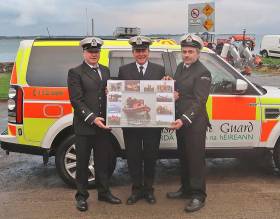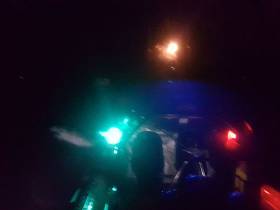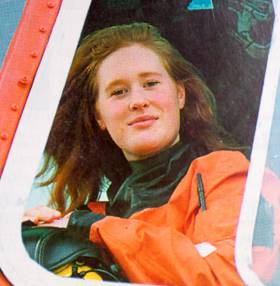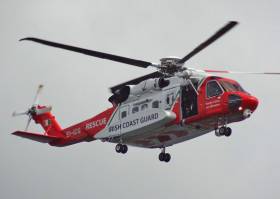Displaying items by tag: Irish Coast Guard
#Coastguard - There was no evidence of effective management at Kilkee’s coastguard station when volunteer Caitríona Lucas died during a rescue operation almost two years ago, according to a draft report into the incident.
The Irish Times has details of the draft report from the Marine Casualty Investigation Board (MCIB), which adds that the RIB on which Lucas was travelling before it capsized on 12 September 2016 was being used outside of the Irish Coast Guard’s own operational limits.
Parallels were also drawn to a similar incident two years prior involving a coastguard RIB in a “surf zone” near Dingle, which prompted a series of recommendation that were not “fully implemented” by the Irish Coast Guard, according to the MCIB.
The Irish Times has much more on the story, while Lorna Siggins also writes on how Lucas’ death occurred amid a tumultuous time for the Co Clare coastguard unit.
Items Recovered Off Achill Could Be From Rescue 116 Crash
#Rescue116 - RTÉ News reports that a lifejacket and helmet thought to be from the Rescue 116 crash last year have been recovered off Achill Island.
Local gardaí confirmed that the items were brought ashore by fishermen about a mile offshore last Thursday 12 July.
The find comes more than nine months after a lifejacket and helmet believed to be from the downed Sikorsky S-92 helicopter washed up on a beach near Blacksod in Co Mayo.
It also comes 16 months after the tragedy that took the lives of four Irish Coast Guard personnel.
Capt Dara Fitzpatrick died shortly after she was recovered from the scene at Black Rock on 14 March 2017. The body of Capt Mark Duffy was recovered almost two weeks later.
Winch operator Paul Ormsby and winchman Ciaran Smith were lost at sea.
The Air Accident Investigation Unit’s probe of the incident remains ongoing.
Rip Current Rescue Launch For Coleraine Coastguard
#Coastguard - Coleraine Coastguard headed to the rescue of a man and three children caught in a rip current at Castlerock over the weekend following the Portrush Raft Race.
According to BBC News, the four were on bodyboards when they were swept away by the current on Saturday 26 May - though they managed to get back to shore before the coastguard team arrived.
None needed hospital treatment, however they were attended to by the NI Ambulance Service for shock and the cold, as well as for swallowing sea water.
As reported earlier on Afloat.ie, Bundoran RNLI were involved in the rescue of a man and boy caught in a rip current off Bundoran beach yesterday (Sunday 27 May).
Elsewhere, the Irish Examiner reports that a man was airlifted to hospital after falling overboard from his boat off the Clare coast yesterday afternoon.
Irish Coast Guard units from Kilkee and Doolin as well as the Rescue 115 helicopter from Shannon were dispatched to the scene, where the man had fallen from a dive boat and was unable to leave the water due to an injury.
The Irish Examiner has more on the story HERE.
Ross Appoints Team To Review Search & Rescue ‘Oversight’ In Wake Of Rescue 116 Tragedy
#Rescue116 - Transport Minister Shane Ross has appointed an international team to review Irish SAR operations in the wake of last year’s fatal Rescue 116 crash, as The Irish Times reports.
The team, led by former European Aviation Safety Agency rulemaking director Prof Jules Kneepkens, includes former Bristol Helicopters coastguard SAR commander Rowan Greenwood, and Milen Dentchev, safety oversight auditor with the International Civil Aviation Organisation.
They have been given two months to report back to the minister with their findings.
The appointment follows March’s interim report from the Air Accident Investigation Unit (AAIU) into the tragedy at Black Rock off Co Mayo on 14 March 2017, which cost the lives of four experienced Irish Coast Guard personnel.
Capt Dara Fitzpatrick was recovered at the scene but died shortly after. The body of Capt Mark Duffy was found almost two weeks later, while winch operator Paul Ormsby and winchman Ciaran Smith were not recovered.
As previously reported on Afloat.ie, the AAIU called for “a thorough review of search and rescue aviation operations in Ireland” as its own investigation into the Rescue 116 incident remains ongoing after more than a year due to its “depth and breadth”.
Minister Ross says the review’s term of reference will “take account of the various findings made in the AAIU’s interim statement in relation to oversight.”
The Irish Times has more on the story HERE.
#Coastguard - Dun Laoghaire Coast Guard was alerted at 10am yesterday morning (Wednesday 16 May) to respond to a woman and her dog who were cut off by the tide on Merrion Strand, near the seaward side of the Dublin incinerator area.
Dublin Coast Guard’s Marine Rescue Coordination Centre (MRCC) activated a procedure with consent to ping the location of the casualty’s phone to give co-ordinates to the responding emergency services.
Dun Laoghaire RNLI and the Dublin-based Irish Coast Guard helicopter Rescue 116 responded to the area and were directed in by the Dun Laoghaire coastguard team.
Rescue 116 proceeded to land on the sand bank while Dun Laoghaire RNLI’s inshore lifeboat stood by to assist. A Dublin Fire Brigade RIB from Dublin Port also responded.
The casualty and her dog were airlifted from the sand bank to awaiting coastguard personal on the beach. After checks by Dublin Fire Brigade paramedics, they were taken back from the beach to land.
Dun Laoghaire Coast Guard noted yesterday’s “very fast” spring tide which caught this dog walker unawares. Tide times for Dublin can be found online HERE.
Video Of Coastguard Cliff Rescue In Dingle
#Coastguard - The Irish Coast Guard’s Facebook page has shared video of a dramatic cliff face rescue near Dingle earlier this week.
Dingle Coast Guard and the Irish Coast Guard’s Shannon-based helicopter Rescue 115 joined paramedics at the scene where a person has fallen around 10 metres down the cliff face on Monday 30 April.
Rescue climbers from the Dingle coastguard unit were able to reach the causality and transfer them to the helicopter for treatment at University Hospital Kerry.
Video of the rescue was captured from the water by Jeannine Masset, a longtime fan of Dingle’s resident dolphin Fungie.
Promotion For Greenore Coast Guard Chief
#Coastguard - Greenore Coast Guard congratulate their retiring officer in chief James Larkin, who is stepping down after 21 years in the post.
Larkin now takes up a full-time role as section manager for the Irish Coast Guard’s Eastern Region.
He is succeeded at the Co Louth coastguard station by George Campbell, who along with deputy OIC Shay Gormley presented Larkin with a canvas on behalf of all Greenore Coast Guard volunteers.
Scariff Bay Yacht Runs Aground Twice In Matter Of Hours
#Rescue - A lone sailor whose yacht ran aground on Scariff Bay over the weekend had difficulties again just hours after his rescue.
As previously reported on Afloat.ie, Lough Derg RNLI launched its lifeboat on Saturday evening (14 April) to assist the 30ft yacht after it had left its mooring at Mountshannon Harbour.
The Killaloe unit of the Irish Coast Guard was also on scene, helping to remove the yacht from a sandy bank and returning it to Mountshannon.
But the evening did not end there, as BreakingNews.ie reports, as the same yacht required coastguard assistance just a few hours later.
It emerged that the sailor was attempting to tie up his vessel at an anchor point in deeper water when it grounded in the shallows once more, and the coastguard was alerted by a concerned onlooker around 11.30pm.
The yacht was once again towed to Mountshannon Harbour and the coastguard unit returned to base at 1.30am.
Tributes To Lost Coastguard Crew At ‘People Of the Year’ Awards
#Rescue116 - The 43rd annual People of the Year awards tomorrow night (Sunday 15 April) will see honours go to the Irish Coast Guard as a tribute to the crew of Rescue 116, as BreakingNews.ie reports.
In addition, the people of Erris in Co Mayo will be noted for their contributions to the search and rescue operation following the tragic loss of the helicopter’s four crew — Capt Dara Fitzpatrick, Capt Mark Duffy, Paul Ormsby and Ciarán Smith — on 14 March 2017.
Caitríona Lucas, the coastguard volunteer who died in a search operation off Kilkee a few months prior, will also be remembered on the evening, broadcast live on RTÉ One tomorrow from 9.30pm.
“The selfless actions of those who put their lives on the line, for the safety of others, means Caitríona, Dara, Ciáran, Mark and Paul will remain an inspiration to us all,” said Gerard O’Flynn, search and rescue operations manager with the Irish Coast Guard.
All five are set to feature in a new commemorative stamp colllection next year, as previously reported on Afloat.ie.
Body Found In Search For Missing Swimmer Off Galway
#Galway - A body was found this morning (Friday 13 April) in the search for a swimmer missing off Salthill in Galway since yesterday.
The Irish Coast Guard’s Shannon-based helicopter Rescue 115 spotted the body on the seabed in shallow water offshore around 10.15am this morning as part of the ongoing search operation.
The body was recovered into Galway RNLI’s inshore lifeboat for transfer to Galway University Hospital. Pending formal identification, the search will be stood down.
Search units involved included An Garda Síochána and Civil Defence teams, and volunteer divers provide by the Irish Underwater Council.


























